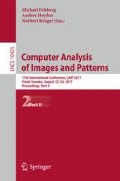Abstract
Currently, Parkinson’s Disease (PD) has no cure or accurate diagnosis, reaching approximately 60, 000 new cases yearly and worldwide, being more often in the elderly population. Its main symptoms can not be easily uncorrelated with other illness, being way more difficult to be identified at the early stages. As such, computer-aided tools have been recently used to assist in this task, but the challenge in the automatic identification of Parkinson’s Disease still persists. In order to cope with this problem, we propose to employ Restricted Boltzmann Machines (RBMs) to learn features in an unsupervised fashion by analyzing images from handwriting exams, which aim at assessing the writing skills of potential individuals. These are one of the main symptoms of PD-prone people, since such kind of ability ends up being severely affected. We show that RBMs can learn proper features that help supervised classifiers in the task of automatic identification of PD patients, as well as one can obtain a more compact representation of the exam for the sake of storage and computational load purposes.
C.R. Pereira and L.A. Passos—Both authors contributed equally.
Access this chapter
Tax calculation will be finalised at checkout
Purchases are for personal use only
Notes
- 1.
Available in http://wwwp.fc.unesp.br/~papa/pub/datasets/Handpd/.
- 2.
Notice the range values were empirically chosen.
References
Parkinson’s Disease Fundation: Statistics on Parkinson’s: Who has Parkinson’s? (2016). http://www.pdf.org/en/parkinson_statistics. Accessed 15 July 2016
Parkinson, J.: An essay on the shaking palsy. J. Neuropsychiatry Clin. Neurosci. 14(2), 223–236 (1817)
Lees, A.J., Hardy, J., Revesz, T.: Parkinson’s disease. Lancet 373(9680), 2055–2066 (2009)
Burke, R.E.: Evaluation of the braak staging scheme for Parkinson’s disease: Introduction to a panel presentation. Mov. Disord. 25(S1), S76–S77 (2010)
Sakar, B.E., Isenkul, M.E., Sakar, C.O., Sertbas, A., Gurgen, F., Delil, S., Apaydin, H., Kursun, O.: Collection and analysis of a Parkinson speech dataset with multiple types of sound recordings. IEEE J. Biomed. Health Inform. 17, 828–834 (2013)
Spadotto, A.A., Guido, R.C., Papa, J.P., Falcão, A.X.: Parkinson’s disease identification through optimum-path forest. In: IEEE International Conference of the Engineering in Medicine and Biology Society, pp. 6087–6090 (2010)
Papa, J.P., Falcão, A.X., Suzuki, C.T.N.: Supervised pattern classification based on optimum-path forest. Int. J. Imaging Syst. Technol. 19(2), 120–131 (2009)
Papa, J.P., Falcão, A.X., Albuquerque, V.H.C., Tavares, J.M.R.S.: Efficient supervised optimum-path forest classification for large datasets. Pattern Recogn. 45(1), 512–520 (2012)
Spadotto, A.A., Guido, R.C., Carnevali, F.L., Pagnin, A.F., Falcão, A.X., Papa, J.P.: Improving Parkinson’s disease identification through evolutionary-based feature selection. In: IEEE International Conference of the Engineering in Medicine and Biology Society, pp. 7857–7860 (2011)
Pereira, C.R., Pereira, D.R., Silva, F.A., Masieiro, J.P., Weber, S.A.T., Hook, C., Papa, J.P.: A new computer vision-based approach to aid the diagnosis of Parkinson’s disease. Comput. Methods Programs Biomed. 136, 79–88 (2016)
Pereira, C.R., Weber, S.A.T., Hook, C., Rosa, G.H., Papa, J.P.: Deep learning-aided Parkinson’s disease diagnosis from handwritten dynamics. In: Proceedings of the 29th SIBGRAPI Conference on Graphics, Patterns and Images, pp. 340–346 (2016)
Larochelle, H., Bengio, Y.: Classification using discriminative restricted Boltzmann machines. In: Proceedings of the 25th International Conference on Machine Learning, pp. 536–543. ACM (2008)
Duda, R.O., Hart, P.E., Stork, D.G.: Pattern Classification, 2nd edn. Wiley-Interscience, New York (2000)
Cortes, C., Vapnik, V.: Support vector networks. Mach. Learn. 20, 273–297 (1995)
Hinton, G.E.: Training products of experts by minimizing contrastive divergence. Neural Comput. 14(8), 1771–1800 (2002)
Pereira, C.R., Pereira, D.R., da Silva, F.A., Hook, C., Weber, S.A.T., Pereira, L.A.M., Papa, J.P.: A step towards the automated diagnosis of Parkinson’s disease: analyzing handwriting movements. In: IEEE 28th International Symposium on Computer-Based Medical Systems, pp. 171–176 (2015)
Germany University of Applied Sciences Team, Regensburg. A novel multisensoric system recording and analyzing human biometric features for biometric and biomedical applications (2002)
Otsu, N.: A threshold selection method from gray-level histograms. IEEE Trans. Syst. Man Cybern. 9(1), 62–66 (1979)
Pedregosa, F., Varoquaux, G., Gramfort, A., Michel, V., Thirion, B., Grisel, O., Blondel, M., Prettenhofer, P., Weiss, R., Dubourg, V., Vanderplas, J., Passos, A., Cournapeau, D., Brucher, M., Perrot, M., Duchesnay, E.: Scikit-learn: machine learning in Python. J. Mach. Learn. Res. 12, 2825–2830 (2011)
Acknowledgments
The authors would like to thank FAPESP grants #2014/16250-9, #2014/12236-1, #2015/25739-4 and #2016/21243-7, as well as Capes, and CNPq grant #306166/2014-3.
Author information
Authors and Affiliations
Corresponding author
Editor information
Editors and Affiliations
Rights and permissions
Copyright information
© 2017 Springer International Publishing AG
About this paper
Cite this paper
Pereira, C.R., Passos, L.A., Lopes, R.R., Weber, S.A.T., Hook, C., Papa, J.P. (2017). Parkinson’s Disease Identification Using Restricted Boltzmann Machines. In: Felsberg, M., Heyden, A., Krüger, N. (eds) Computer Analysis of Images and Patterns. CAIP 2017. Lecture Notes in Computer Science(), vol 10425. Springer, Cham. https://doi.org/10.1007/978-3-319-64698-5_7
Download citation
DOI: https://doi.org/10.1007/978-3-319-64698-5_7
Published:
Publisher Name: Springer, Cham
Print ISBN: 978-3-319-64697-8
Online ISBN: 978-3-319-64698-5
eBook Packages: Computer ScienceComputer Science (R0)

